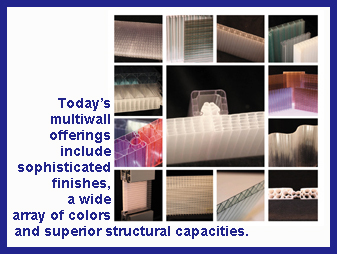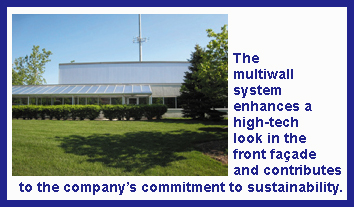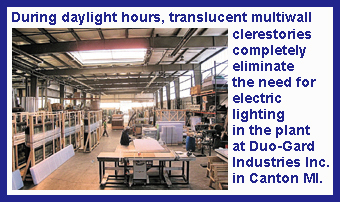|
Today's Multiwall PC Technology Integrates Aesthetics, Sustainability and Economy
Today’s multiwall offerings include sophisticated
finishes, a wide array of colors and superior
structural capacities.
 Few glazing materials
have progressed as far
and as fast in recent
years as translucent multiwall
polycarbonates. Advances in
thickness, texture, tint, thermal
value and performance,
combined with design versatility,
make this daylighting
alternative an increasingly
preferred element of sustainable
building.
Few glazing materials
have progressed as far
and as fast in recent
years as translucent multiwall
polycarbonates. Advances in
thickness, texture, tint, thermal
value and performance,
combined with design versatility,
make this daylighting
alternative an increasingly
preferred element of sustainable
building.
The industry saw a 5%
increase in 2009, in the
middle of a major recession.
The multiwall market estimates
an 8% increase in
2010. There are sound reasons
for this:
Green building is now the
norm; daylighting is an
increasingly important component,
and many applications
don’t require a view.
Traditional direct daylighting
with glass can create glare, hot
spots and solar gain, which in turn create uncomfortable,
unproductive environments and high operating costs.
Diffuse daylighting provides the benefits of natural lighting
– and projects it 33% deeper into a space – as it eliminates
these disadvantages.
Structural capacities allow for engineering systems that
can withstand the impact of hurricane-velocity winds and
will pass large-missile impact tests.
Multi-wall sheet products can integrate with other new
technologies that enhance performance, especially energy
efficiency.
Improvements in weatherization and fire safety have
made multiwalls a more attractive alternative in commercial,
industrial, educational and government facilities.
Many carry a CC1 – Class A fire rating. Most have UV protection
co-extruded into the sheet, preventing discoloration
and light loss.
Architects and designers are now appraising this previously
overlooked material and appreciating what they see
in aesthetics, energy efficiency and economy – often with
initial costs one-third to
one-half less than traditional
alternatives.
While three primary suppliers
provide the resin
worldwide for multiwall
sheet extrusion, each
extruder enhances the
product with its own, often
exclusive, features. Finishes
vary widely. The slick, high
gloss of previous multiwalls
has been replaced with textured
finishes in hammered
crystal and satin mattes.
Colors range from standard
blue, green, bronze, opal
and clear to lavender, red,
yellow, gray and more.
Specialties include sheets
with a structural “rippling
wave” effect. Thicknesses in
6mm to 40mm+ provide Uvalues
down to 0.19 with Rvalues
up to 5.26. Light transmission
can reach 92%. And
the material is 100% recyclable.
Exceptional energy efficiency can be achieved by filling
the sheet’s cells with a new translucent aerogel that doubles
the thermal value, while maintaining high light transmission.
Another new technology in spectrally selective
coatings places a transparent film in the cells’ interior,
blocking up to 95% of infrared rays, 99% of UV rays and
up to 85% of solar energy, while maintaining light transmission
to 65%.
 Design versatility is major factor in multiwall’s growing
popularity. The sheets, which can be ordered up to 39’ in
length, cold-form easily in dramatic curves. The translucency
enables a designer to use backlighting, including
low-voltage LED arrays, to create environments that
soothe, excite and inspire occupants. And the lighter
weight in this shatterproof material allows for larger spans
with less support required.
Design versatility is major factor in multiwall’s growing
popularity. The sheets, which can be ordered up to 39’ in
length, cold-form easily in dramatic curves. The translucency
enables a designer to use backlighting, including
low-voltage LED arrays, to create environments that
soothe, excite and inspire occupants. And the lighter
weight in this shatterproof material allows for larger spans
with less support required.
Today’s translucent multiwall technology lends itself to a
wide range of applications from skylights to vertical glazing
of all types to canopies to interior walls.
Industrial applications are just one
prime example. When Duo-Gard
Industries Inc, located in Canton
Michigan, updated its headquarters
in late 2009, it replaced 13-year-old
multiwall clerestories with today’s
advanced technology. The company
is a leading innovator in developing
high-performance translucent daylighting
systems for the architectural
market.
“We practice what we preach,” said
David Miller, Duo-Gard’s President.
“Today’s multiwall performance and
aesthetics far outpace yesterdays.
Our previous system required a layer
of translucent thermal foam to
achieve the desired insulation along
with light transmission. This created
some problems that we wanted to
eliminate.”
Duo-Gard selected a 20mm
tongue-and-groove multiwall glazing
from Co-Ex Corporation for the
replacement. Now the 20,000
square foot facility sports a clerestory
12’ high by 275’ long on its south
and west elevations. The west wall
includes a 20-foot-wide section of
operable panels for ventilation.

Miller said the mullionless tongueand-
groove system in the opal tint
chosen enhances the facility’s facade
as it allows 47% visible light transmission,
and the 20mm thickness
carries a 0.35 U-value, R-4 thermal
rating. “This gives us more light –
usable, diffused daylight - with the
same thermal value as before,” he
said, adding that the plant’s long
banks of metal halide lights are never
on during days with adequate sunlight,
resulting in a 33% - 50% savings
in electricity. Installation of the
tongue-and-groove system took only
7 days instead of an estimated 11.
Along with the advantages of
today’s multiwall polycarbonates
come some cautions. The material’s
UV-protected surface must face out.
A multiwall system must be dryglazed.
Because it has a higher coefficient
of expansion than glass, it
requires special framing systems
engineered to accommodate this factor.
Multiwalls must “float” in the
frame: standard framings for glass
grip too tightly to allow this.
Although it’s virtually shatterproof,
the material can be scratched, so
specifiers need to choose applications
carefully and select an appropriate
surface texture. Because of the
material’s diversity in performance
and aesthetics, it’s important to be
sure the choice of material effectively
suits the proposed application.
Properly evaluated and applied,
today’s multiwall polycarbonate technology
gives those involved with the
green building movement an opportunity
to combine exceptional aesthetics,
energy efficiency and economy
in daylighting.
For more information, contact
Kurt Glazer, CO-EX Corporation, 5
Alexander Drive, Wallingford, CT
06492, 800-888-5364, Fax: 203-679-0600, E-mail: info@co-excorp.com. Web:
www.co-excorp.com.
|